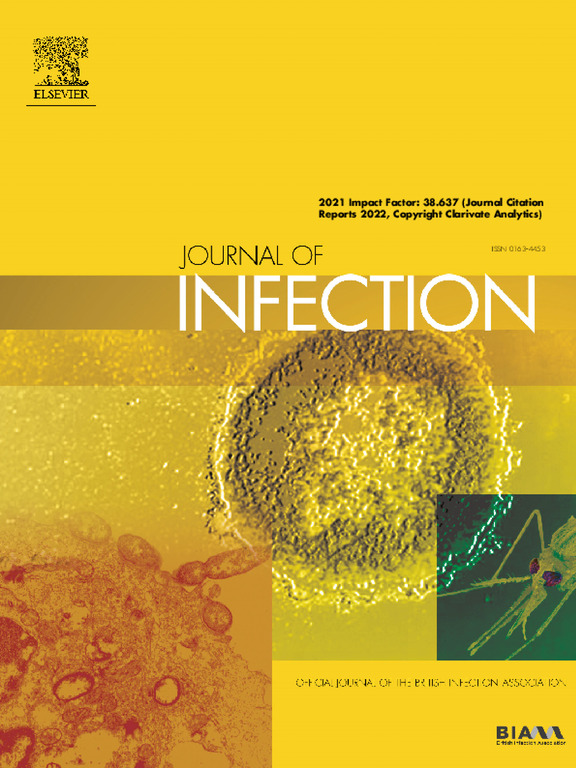评估冈比亚儿童化脓性链球菌咽炎诊断的临床决策规则和快速诊断试验:诊断准确性研究
IF 11.9
1区 医学
Q1 INFECTIOUS DISEASES
引用次数: 0
摘要
目的:在风湿性心脏病高负担国家,准确诊断化脓性链球菌(S. pyogenes)咽炎势在必行。我们旨在评估冈比亚两种快速诊断测试和五种临床决策规则(cdr)的诊断准确性。方法:在冈比亚Sukuta保健中心招募有咽炎体征和症状的16岁以下儿童。快速抗原检测试验(SD Bioline;LFT)和快速基因扩增试验(ID NOW™STREP A2)与5种cdr对照培养和qPCR对化脓性链球菌的诊断准确性进行了评估。采用Logistic回归确定化脓性链球菌咽炎的危险因素。结果:376名参与者中,化脓性链球菌培养阳性率为9.8% (37/376),PCR阳性率为32.4% (122/376),LFT阳性率为31.6% (119/376),ID NOW阳性率为33.3%(122/366)。该方法对培养的敏感性和特异性分别为94.6%和73.6%,对PCR的敏感性和特异性分别为93.5%和86.7%。LFT对培养的敏感性和特异性分别为83.8%和71.4%,对PCR的敏感性和特异性分别为55.7%和80.8%。Smeesters CDR效果最好,曲线下面积(AUC)为0·694。化脓性链球菌咽炎风险随年龄增加而增加。近期胸部感染/咳嗽(aOR为1.89,1.08 - 3.28)和并发皮肤感染(aOR为2.11,1.21 - 3.69)与化脓性链球菌咽炎增加相关。结论:与PCR和培养相比,LFT和cdr检测化脓链球菌咽炎的效果较差。分子法检测化脓性葡萄球菌的比例高于培养法。在资源有限的环境中,迫切需要负担得起和敏感的诊断方法来改善化脓性链球菌的管理。本文章由计算机程序翻译,如有差异,请以英文原文为准。
Evaluating clinical decision rules and rapid diagnostic tests for the diagnosis of Streptococcus pyogenes pharyngitis in Gambian children: A diagnostic accuracy study
Objectives
Accurate diagnosis of Streptococcus pyogenes (S. pyogenes) pharyngitis is imperative in high rheumatic heart disease-burden countries. We aimed to assess the diagnostic accuracy of two rapid diagnostic tests and five clinical decision rules (CDRs) in The Gambia.
Methods
Children under 16 years presenting with signs and symptoms of pharyngitis were recruited at Sukuta Health Centre, The Gambia. A rapid antigen detection test (SD Bioline; LFT) and a rapid gene-amplification test (ID NOW™ STREP A2) were assessed for diagnostic accuracy alongside five CDRs against culture and qPCR for S. pyogenes. Logistic regression was used to determine risk factors for S. pyogenes pharyngitis.
Results
Among 376 participants, S. pyogenes positivity was 9·8% (37/376) by culture, 32·4% (122/376) by PCR, 31·6% (119/376) by LFT, and 33·3% (122/366) by ID NOW. The ID NOW had sensitivities and specificities of 94·6% and 73·6% against culture, and 93·5% and 87·6% against PCR. The LFT had sensitivities and specificities of 83·8% and 74·0% against culture and 55·7% and 80·0% against PCR. The Smeesters CDR performed best with an area under the curve (AUC) of 0·694 against culture. S. pyogenes pharyngitis risk increased with age. Recent chest infection/cough (aOR 1·89, 1·08–3·28) and concurrent skin infection (aOR 2·11, 1·21–3·69) were associated with increased S. pyogenes pharyngitis.
Conclusions
The LFT and the CDRs had poor performance in detecting S. pyogenes pharyngitis compared to PCR and culture. Molecular methods detected a higher proportion of S. pyogenes than culture. Affordable and sensitive diagnostics are urgently needed to improve S. pyogenes management in resource-limited settings.
求助全文
通过发布文献求助,成功后即可免费获取论文全文。
去求助
来源期刊

Journal of Infection
医学-传染病学
CiteScore
45.90
自引率
3.20%
发文量
475
审稿时长
16 days
期刊介绍:
The Journal of Infection publishes original papers on all aspects of infection - clinical, microbiological and epidemiological. The Journal seeks to bring together knowledge from all specialties involved in infection research and clinical practice, and present the best work in the ever-changing field of infection.
Each issue brings you Editorials that describe current or controversial topics of interest, high quality Reviews to keep you in touch with the latest developments in specific fields of interest, an Epidemiology section reporting studies in the hospital and the general community, and a lively correspondence section.
 求助内容:
求助内容: 应助结果提醒方式:
应助结果提醒方式:


